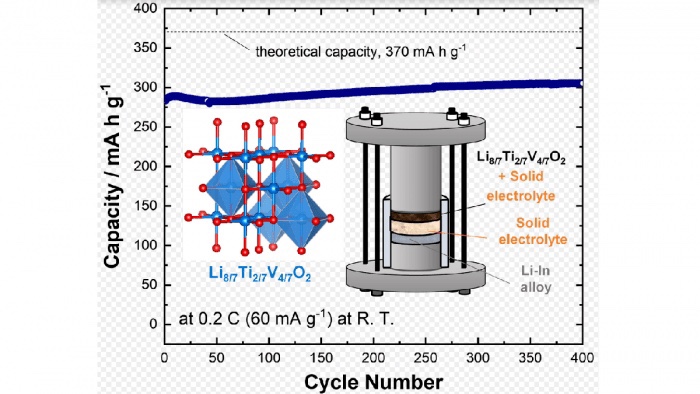

All-solid-state battery: solving the problem of durability!
ーDevelopment of volume-invariant cathode materials at the atomic levelー
Yokohama National University:
We have developed a positive electrode material for all-solid-state batteries whose volume does not change at the atomic level.
The volume of the crystal lattice does not change when LIB is de-inserted into the electrode material.
Therefore, deterioration of the all-solid-state battery can be suppressed.
Validate Durability:
-Constructing a sulfide-based electrolyte and an all-solid-state battery and verifying its durability-
After 400 charge/discharge cycles, no deterioration of the all-solid-state battery was observed.
All-solid-state batteries and durability issues will be resolved.
Lithium-rich vanadium-based materials:
We have developed a lithium-rich vanadium-based material with a rock salt-type crystal structure.
When discharging:
Vanadium becomes a trivalent ion when lithium ions are inserted.
When charging:
When the lithium ions are removed, vanadium becomes a pentavalent ion.
The vanadium ions move and swell as the lithium ions are removed,
“Keep the volume of the crystal as a whole constant.”
Battery performance deterioration is:
the battery
“The volume of the electrode changes, creating a gap between the electrolyte and the electrode,” which degrades performance.
If there is no volume change, deterioration can be prevented.
Conducted 400 charge/discharge cycles:
ー300mA/hour per gram of capacityー
An all-solid-state battery was actually assembled with a lithium alloy as the negative electrode and a sulfide-based electrolyte.
After 400 charge/discharge cycles, the capacity did not change.
new switch
https://news.yahoo.co.jp/articles/1b92f32c4ae9e9eaf029cbd8cc1cfb59cfe0ebf0
Batterie tout solide : résoudre le problème de la durabilité !
ーDéveloppement de matériaux cathodiques invariants en volume au niveau atomiqueー
Université nationale de Yokohama :
Nous avons développé un matériau d’électrode positive pour les batteries tout solide dont le volume ne change pas au niveau atomique.
Le volume du réseau cristallin ne change pas lorsque LIB est désinséré dans le matériau d’électrode.
Par conséquent, la détérioration de la batterie entièrement à semi-conducteurs peut être supprimée.
Valider la durabilité :
-Construire un électrolyte à base de sulfure et une batterie tout solide et vérifier sa durabilité-
Après 400 cycles de charge/décharge, aucune détérioration de la batterie tout solide n’a été observée.
Les batteries à semi-conducteurs et les problèmes de durabilité seront résolus.
Matériaux à base de vanadium riche en lithium :
Nous avons développé un matériau à base de vanadium riche en lithium avec une structure cristalline de type sel gemme.
Lors de la décharge :
Le vanadium devient un ion trivalent lorsque des ions lithium sont insérés.
Lors de la charge :
Lorsque les ions lithium sont éliminés, le vanadium devient un ion pentavalent.
Les ions vanadium se déplacent et gonflent au fur et à mesure que les ions lithium sont éliminés,
“Gardez le volume du cristal dans son ensemble constant.”
La détérioration des performances de la batterie est :
la batterie
“Le volume de l’électrode change, créant un espace entre l’électrolyte et l’électrode”, ce qui dégrade les performances.
S’il n’y a pas de changement de volume, la détérioration peut être évitée.
Effectué 400 cycles de charge/décharge :
ー300mA/heure par gramme de capacitéー
Une batterie entièrement à l’état solide était en fait assemblée avec un alliage de lithium comme électrode négative et un électrolyte à base de sulfure.
Après 400 cycles de charge/décharge, la capacité n’a pas changé.
nouvel interrupteur
All-Solid-State-Batterie: Lösung des Problems der Haltbarkeit!
ーEntwicklung von volumeninvarianten Kathodenmaterialien auf atomarer Ebeneー
Nationale Universität Yokohama:
Wir haben ein positives Elektrodenmaterial für All-Solid-State-Batterien entwickelt, dessen Volumen sich auf atomarer Ebene nicht ändert.
Das Volumen des Kristallgitters ändert sich nicht, wenn LIB in das Elektrodenmaterial eingelagert wird.
Daher kann eine Verschlechterung der Festkörperbatterie unterdrückt werden.
Validieren Sie die Haltbarkeit:
-Konstruktion eines Sulfid-basierten Elektrolyten und einer All-Solid-State-Batterie und Überprüfung ihrer Haltbarkeit-
Nach 400 Lade-/Entladezyklen wurde keine Verschlechterung der Festkörperbatterie beobachtet.
All-Solid-State-Batterien und Haltbarkeitsprobleme werden gelöst.
Lithiumreiche Materialien auf Vanadiumbasis:
Wir haben ein lithiumreiches Material auf Vanadiumbasis mit einer steinsalzartigen Kristallstruktur entwickelt.
Beim Entladen:
Vanadium wird zu einem dreiwertigen Ion, wenn Lithium-Ionen eingefügt werden.
Beim Laden:
Wenn die Lithiumionen entfernt werden, wird Vanadium zu einem fünfwertigen Ion.
Die Vanadiumionen bewegen sich und schwellen an, wenn die Lithiumionen entfernt werden,
“Halte das Volumen des Kristalls als Ganzes konstant.”
Die Verschlechterung der Batterieleistung ist:
die Batterie
„Das Volumen der Elektrode ändert sich, wodurch ein Spalt zwischen dem Elektrolyten und der Elektrode entsteht“, was die Leistung verschlechtert.
Wenn es keine Volumenänderung gibt, kann eine Verschlechterung verhindert werden.
400 Lade-/Entladezyklen durchgeführt:
ー300 mA/Stunde pro Gramm Kapazitätー
Tatsächlich wurde eine Festkörperbatterie mit einer Lithiumlegierung als negative Elektrode und einem Elektrolyten auf Sulfidbasis zusammengebaut.
Nach 400 Lade-/Entladezyklen änderte sich die Kapazität nicht.
neuer Schalter
Long-life electrode material for solid-state EV batteries
Now, a team of researchers led by Professor Naoaki Yabuuchi of Yokohama National University, Japan,
has investigated a new type of positive electrode material with unprecedented stability in solid-state batteries.
The material is made up of lithium titanate and lithium vanadium dioxide, ball-milled down to an appropriate particle size in the order of nanometers.
This material offers high capacity thanks to its large quantity of lithium ions that can be reversibly inserted and extracted during the charge and discharge process.
The result is an electrolyte material
that retains its volume throughout charging to enable the battery to endure hundreds of cycles.
The researchers analyzed the origin of this property and concluded that
it is the result of a fine balance between two independent phenomena that occur when lithium ions are inserted or extracted from the crystal.
On the one hand,
the removal of lithium ions causes an increase in free volume in the crystal, which makes it shrink.
On the other hand,
some vanadium ions migrate from their original position to the spaces left behind by the lithium ions, acquiring a higher oxidation state in the process.
https://www.inceptivemind.com/long-life-electrode-material-solid-state-ev-batteries/28751/
A near dimensionally invariable high-capacity positive electrode material